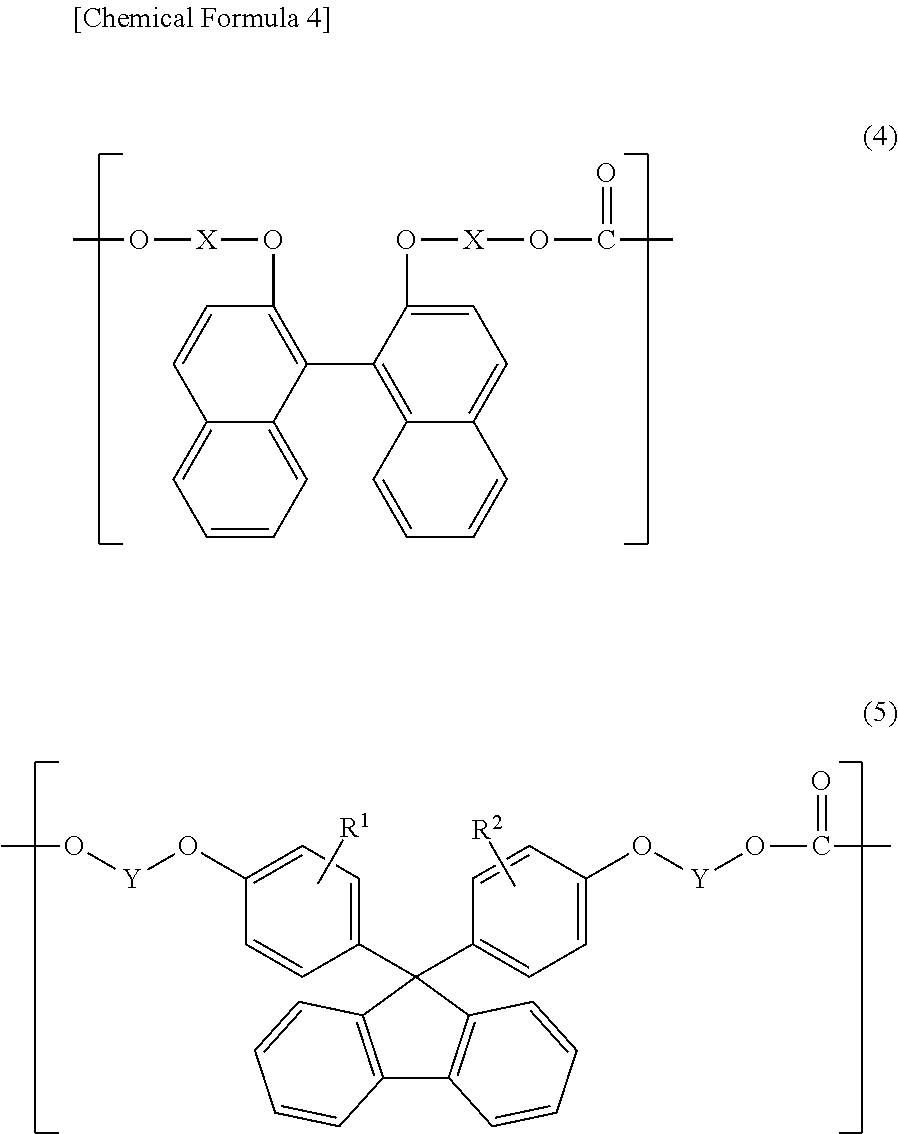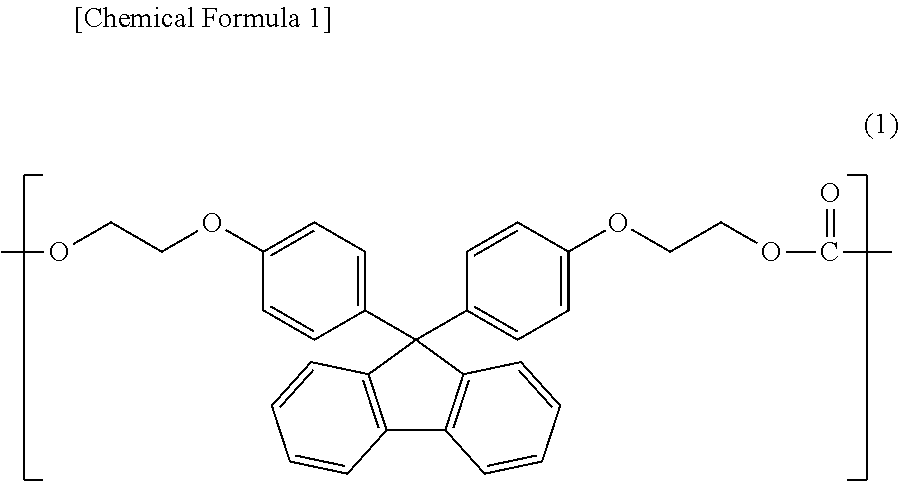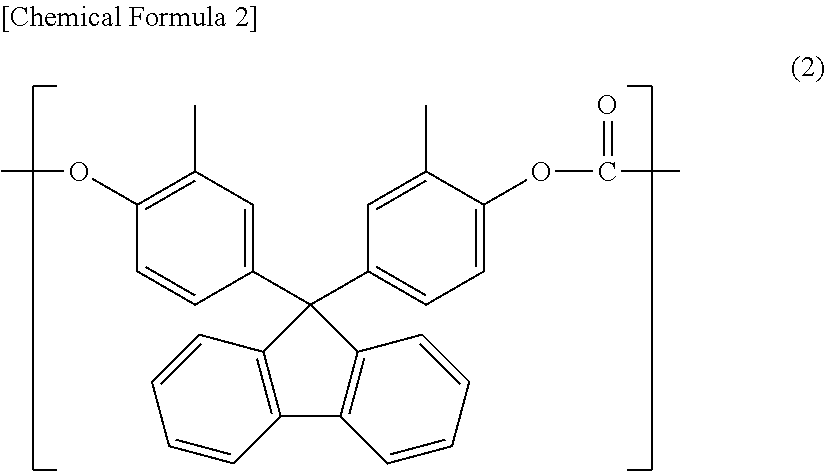Polycarbonate resin composition, and optical material and optical lens each manufactured using same
a polycarbonate resin and composition technology, applied in the field of polycarbonate resin composition and optical molded body, can solve the problems of limited application of a polycarbonate resin made of bisphenol a, limited softening temperature, and limited upper limit of mold temperature to about 150° c, etc., to achieve low abbe's number, high transparency, and high refractive index
- Summary
- Abstract
- Description
- Claims
- Application Information
AI Technical Summary
Benefits of technology
Problems solved by technology
Method used
Image
Examples
synthetic example 1
Production of Polycarbonate Resin (A1)
[0187]20.0 kg (53.4 moles) of 2,2′-bis(2-hydroxyethoxy)-1,1′-binaphthyl, 11.7 kg (54.5 moles) of diphenyl carbonate and 6.7×10−2 g (8.0×10−4 moles) of sodium hydrogen carbonate were placed into a 50-liter reactor equipped with an agitator and a distillation device, heated and agitated to 200° C. under a nitrogen atmosphere of 760 mmHg by spending an hour. Subsequently, agitation was performed for 110 minutes under the same conditions. Then, the decompression degree was adjusted to 200 mmHg by spending 20 minutes, and the resultant was maintained under the conditions of 200° C. and 200 mmHg for 40 minutes for transesterification. Furthermore, the temperature was increased to 230° C. at a rate of 45° C. / hr, and the resultant was maintained at 230° C. and 200 mmHg for 10 minutes. Thereafter, the decompression degree was adjusted to 150 mmHg by spending 20 minutes, and the resultant was maintained at 230° C. and 150 mmHg for 10 minutes. Thereafter, ...
synthetic example 2
Production of Polycarbonate Resin (B1)
[0188]19.5 kg (44.5 moles) of 9,9-bis(4-(2-hydroxyethoxy)phenyl)fluorene, 9.93 kg (46.3 moles) of diphenyl carbonate, and 2.2×10−2g (2.7×10−4 moles) of and sodium hydrogen carbonate were placed into a 50-liter reactor equipped with an agitator and a distillation device, heated and agitated to 215° C. under a nitrogen atmosphere of 760 mmHg for an hour. Then, the decompression degree was adjusted to 150 mmHg by spending 15 minutes, and the resultant was maintained under the conditions of 215° C. and 15 mmHg for 20 minutes for transesterification. Furthermore, the temperature was increased to 240° C. at a rate of 37.5° C. / hr, and the resultant was maintained at 240° C. and 150 mmHg for 10 minutes. Thereafter, the decompression degree was adjusted to 120 mmHg by spending 10 minutes, and the resultant was maintained at 240° C. and 120 mmHg for 70 minutes. Thereafter, the decompression degree was adjusted to 100 mmHg by spending 10 minutes, and the r...
example 1
[0189]0.44 kg of the polycarbonate resin pellets (A1) produced in Synthetic Example 1 and 4.57 kg of the polycarbonate resin pellets (B1) produced in Synthetic Example 2 were thoroughly shaken up, then the polycarbonate resin (A1) and the polycarbonate resin (B1) in molten states were kneaded with an extruder (IPEC IPT-type 35 mm co-rotating twin-screw extruder) at 260° C. and a vent pressure of 25 mmHg, and the resultant was pelletized to obtain 3.3 kg of blend pellets. Tg of the pellets was 142° C. with no inflection point. Moreover, Mw of the pellets was 26,000. These pellets were injection molded to obtain a circular disc with a diameter of 50 mm and a thickness of 3 mm. The circular disc was transparent. The evaluation results are shown in Table 1.
PUM
| Property | Measurement | Unit |
|---|---|---|
| Tg | aaaaa | aaaaa |
| mold temperature | aaaaa | aaaaa |
| glass-transition temperature | aaaaa | aaaaa |
Abstract
Description
Claims
Application Information
 Login to View More
Login to View More - R&D
- Intellectual Property
- Life Sciences
- Materials
- Tech Scout
- Unparalleled Data Quality
- Higher Quality Content
- 60% Fewer Hallucinations
Browse by: Latest US Patents, China's latest patents, Technical Efficacy Thesaurus, Application Domain, Technology Topic, Popular Technical Reports.
© 2025 PatSnap. All rights reserved.Legal|Privacy policy|Modern Slavery Act Transparency Statement|Sitemap|About US| Contact US: help@patsnap.com



